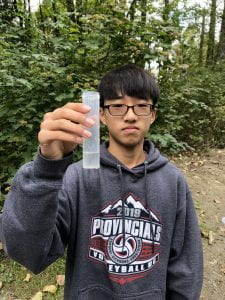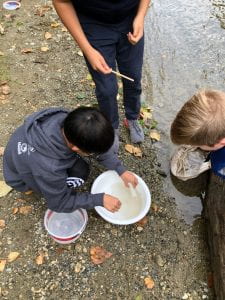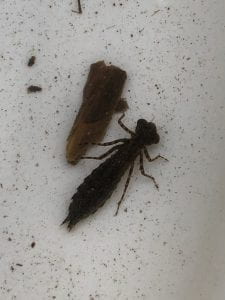Field Studies Blog
In Science 9 Honours this unit, we have learned about the 4 spheres and how different scenarios affect different spheres, the food web and cycle of different ecosystems, water sheds and invertebrates. While we were studying invertebrates, we went to two different water sheds to exam their water quality and other factors such as dissolved oxygen, pH, nitrates, turbidity and more. The water quality of both the river and pond were quite healthy although the river’s water was a little bit higher in the water quality index. We measured the water quality using the weighted Q-value of both the pond and river. We found the weighted Q-value by turning our result into a Q-value, then multiplying it by the weighting factor. For example, the river was 3°, the Q-value of that is 88, we then multiply it by 0.15 to the weighted Q-value which is 13.2.

The river had a total weighted Q-value of 89.76 while the pond had a score of 74.14. There are many similarities and differences in the weighted Q-value of both categories. For example, both the river and pond have a nitrate value of 13.72. The biggest difference between the two aquatic fields is their phosphate quantities. The river has a grand number of 10.64 while the pond has a weighted Q-value of 1.96. We found many more animals in the pond then we did in the river, perhaps due to the flowing current in the river, or it could be due to the pH level of the river. The river had a pH level of 13.2 which is quite high, while the pond had a level of 8.1 which seems more habitable for invertebrates and other creatures we found.
My group and I found many different critters in both the river and pond. In the pond, the invertebrates that we found were a dragon suborder nymph, snail, spider and a dragonfly nymph. The vertebrates we found were a fish, and a notonectidae. All these animals were easy to catch and did not require too much effort. In the river, the invertebrates we caught were a snail, mayfly nymph, a small leech and dragonfly nymph. It was far more difficult to catch creatures in the river then it was in the pond because the river was part of the midreach of a watershed with moderately fast flowing water. In the river, a member of our group had to go into to the river and scrape rocks to eventually find a critter of some sort. In the pond, I had to put my net at the point where the land and water meet and move it alongside to find something. The river was larger and faster flowing then the still watered pond so there was a higher chance to catch an animal.

Other groups caught things some invertebrates that we have not caught, some critters they found in the pond were a water mite, crane fly larvae and a mayfly nymph. Most of these critters fall into the categories of being scraper, predators and some collectors. Some can fall into more than one category such as the caddisfly larvae is a shredder, collector, scraper and predator. That means there should be many of them compared to some other invertebrates because they have more biodiversity. They can eat almost any food source found in an aquatic field including, insects, algae and slightly decomposed leaves.
If we come back to the water quality index values of both the river and pond, the river has a value that is 15.62 points higher than the pond. That means there could be more invertebrates and vertebrates living in the river. The reason why we couldn’t find as many was most likely because it was more spacious, and the water was flowing. That means the rivers water is more biodiverse and can be more habitable. Another reason why my group and I could have not found as many creatures is because they could have been more spread out due to the size of the river. The pond was very cramp and had quite a few animals but in a smaller space making them far easier to catch. The river also had more phosphates, more dissolved oxygen and more pH which can be pros and cons if there is too much or not enough comparing to the pond. The only factor the pond had more of comparing to the river was temperature change.
Although the rivers water had a higher index value, if we look from a different perspective and think river was better for the animals, we can find quite a few good reasons why too. For example, the river had higher values but maybe some values were too high? What if the ponds levels were lower but more habitable and biodiverse? I keep thinking to myself if maybe the pond was better than the river because its levels were not as high, because everybody knows too much of something is not good. Maybe the reason why my group could not have caught as many animals was because there weren’t as many animals in the specific location we were looking around. Although these are all good arguments, I still believe that the river was better considering it has a higher water quality index and it was far more spacious. This means the river is more diverse and the water is cleaner. Just by at the river and pond water, you can see how much clearer the river is.
In conclusion, I really enjoyed learning about invertebrates and aquatic fields, it was the most fun and interesting thing I have done in any science class so far. My favourite part was for sure when I got to put on the chest waiters and go into the pond to find invertebrates. I also learned so much about how different things can affect different animals such as turbidity or total dissolved salt levels in water. One way I think we could make this activity more meaningful would be by only visiting one aquatic field per day to have more time in the water, instead of visiting both the river and pond on one day. In conclusion, the river had better quality water and was also more diverse.


